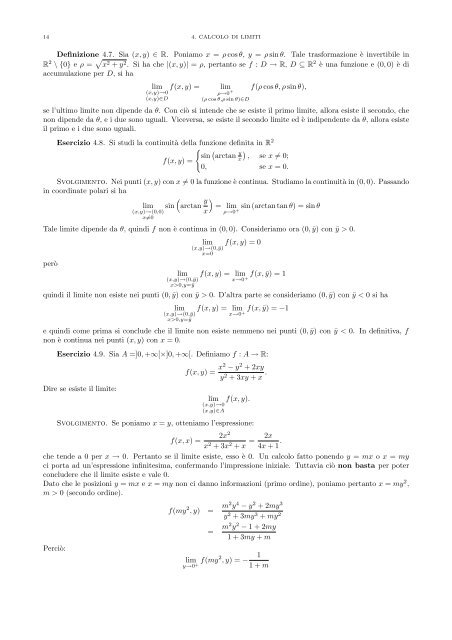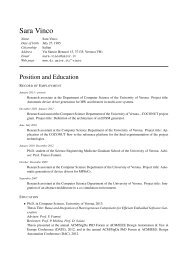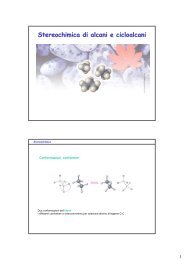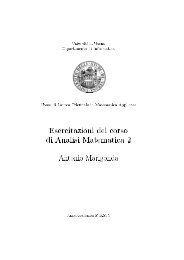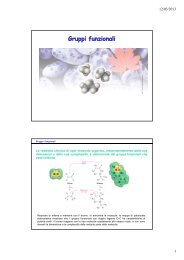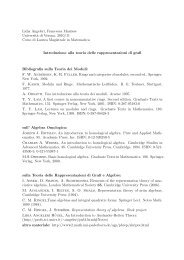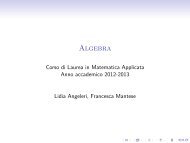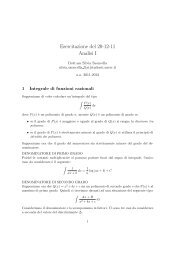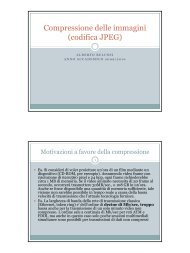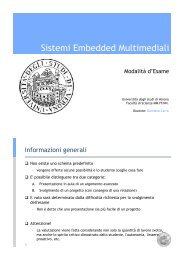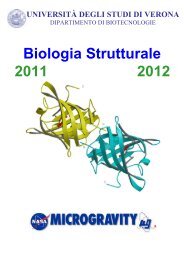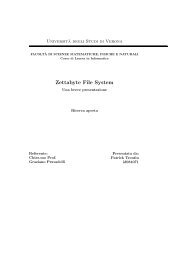You also want an ePaper? Increase the reach of your titles
YUMPU automatically turns print PDFs into web optimized ePapers that Google loves.
14 4. CALCOLO DI LIMITI<br />
Definizione 4.7. Sia (x, y) ∈ R. Poniamo x = ρ cos θ, y = ρ sin θ. Tale trasformazione è invertibile in<br />
R 2 \ {0} e ρ = x 2 + y 2 . Si ha che |(x, y)| = ρ, pertanto se f : D → R, D ⊆ R 2 è una funzione e (0, 0) è di<br />
accumulazione per D, si ha<br />
lim<br />
(x,y)→0<br />
(x,y)∈D<br />
f(x, y) = lim<br />
ρ→0 +<br />
(ρ cos θ,ρ sin θ)∈D<br />
f(ρ cos θ, ρ sin θ),<br />
se l’ultimo lim<strong>it</strong>e non dipende da θ. Con ciò si intende che se esiste il primo lim<strong>it</strong>e, allora esiste il secondo, che<br />
non dipende da θ, e i due sono uguali. Viceversa, se esiste il secondo lim<strong>it</strong>e ed è indipendente da θ, allora esiste<br />
il primo e i due sono uguali.<br />
Esercizio 4.8. Si studi la continu<strong>it</strong>à della funzione defin<strong>it</strong>a in R2 <br />
sin<br />
f(x, y) =<br />
arctan y <br />
x , se x = 0;<br />
0, se x = 0.<br />
Svolgimento. Nei punti (x, y) con x = 0 la funzione è continua. Studiamo la continu<strong>it</strong>à in (0, 0). Passando<br />
in coordinate polari si ha<br />
lim<br />
<br />
sin arctan y<br />
<br />
= lim sin (arctan tan θ) = sin θ<br />
x ρ→0 +<br />
(x,y)→(0,0)<br />
x=0<br />
Tale lim<strong>it</strong>e dipende da θ, quindi f non è continua in (0, 0). Consideriamo ora (0, ¯y) con ¯y > 0.<br />
però<br />
lim<br />
(x,y)→(0,¯y)<br />
x>0,y=¯y<br />
lim<br />
(x,y)→(0,¯y)<br />
x=0<br />
f(x, y) = 0<br />
f(x, y) = lim f(x, ¯y) = 1<br />
x→0 +<br />
quindi il lim<strong>it</strong>e non esiste nei punti (0, ¯y) con ¯y > 0. D’altra parte se consideriamo (0, ¯y) con ¯y < 0 si ha<br />
lim<br />
(x,y)→(0,¯y)<br />
x>0,y=¯y<br />
f(x, y) = lim f(x, ¯y) = −1<br />
x→0 +<br />
e quindi come prima si conclude che il lim<strong>it</strong>e non esiste nemmeno nei punti (0, ¯y) con ¯y < 0. In defin<strong>it</strong>iva, f<br />
non è continua nei punti (x, y) con x = 0.<br />
Esercizio 4.9. Sia A =]0, +∞[×]0, +∞[. Definiamo f : A → R:<br />
Dire se esiste il lim<strong>it</strong>e:<br />
f(x, y) = x2 − y 2 + 2xy<br />
y 2 + 3xy + x .<br />
lim<br />
(x,y)→0<br />
(x,y)∈A<br />
f(x, y).<br />
Svolgimento. Se poniamo x = y, otteniamo l’espressione:<br />
2x<br />
f(x, x) =<br />
2<br />
x2 + 3x2 2x<br />
=<br />
+ x 4x + 1 .<br />
che tende a 0 per x → 0. Pertanto se il lim<strong>it</strong>e esiste, esso è 0. Un calcolo fatto ponendo y = mx o x = my<br />
ci porta ad un’espressione infin<strong>it</strong>esima, confermando l’impressione iniziale. Tuttavia ciò non basta per poter<br />
concludere che il lim<strong>it</strong>e esiste e vale 0.<br />
Dato che le posizioni y = mx e x = my non ci danno informazioni (primo ordine), poniamo pertanto x = my2 ,<br />
m > 0 (secondo ordine).<br />
Perciò:<br />
f(my 2 , y) = m2 y 4 − y 2 + 2my 3<br />
y 2 + 3my 3 + my 2<br />
= m2 y 2 − 1 + 2my<br />
1 + 3my + m<br />
lim<br />
y→0 + f(my2 , y) = − 1<br />
1 + m


